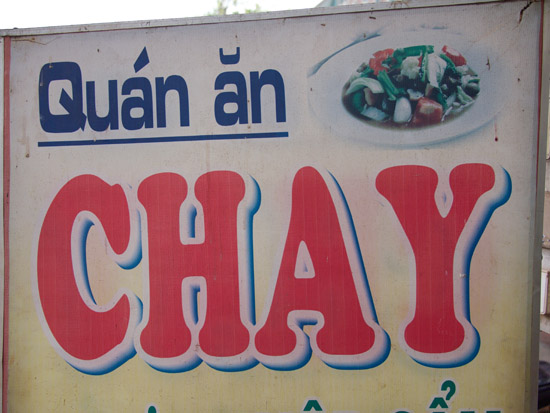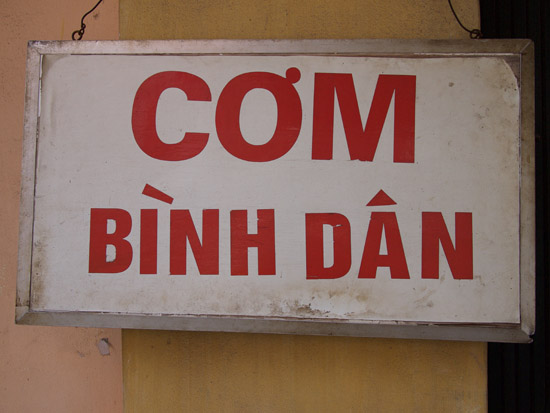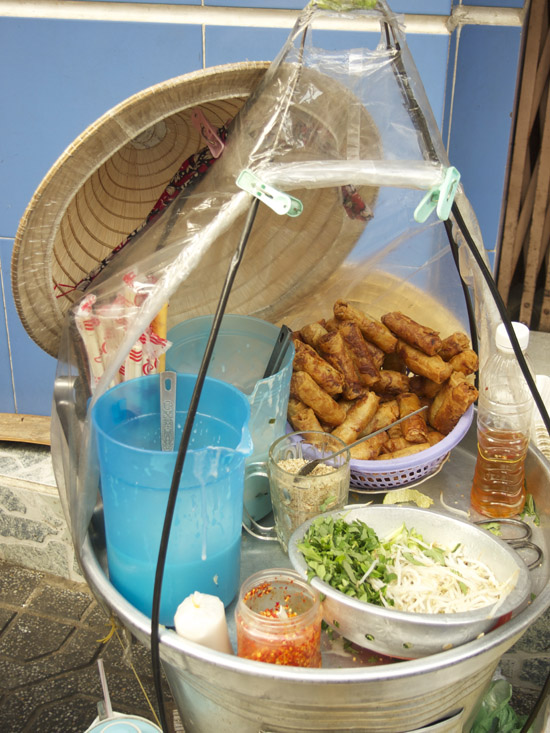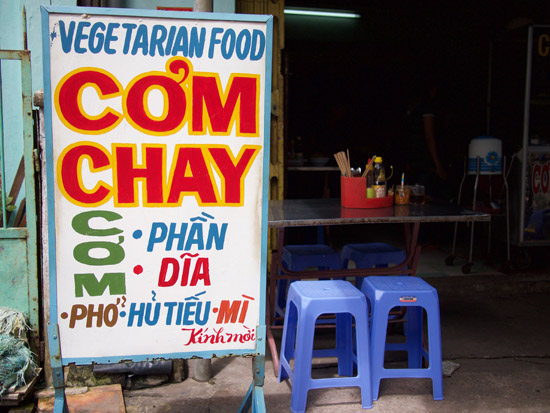If you’re planning a trip (or even a move) to Vietnam don’t let anyone convince you that you’ll have a hard time finding good vegetarian food to eat. Almost all of the vegetarian dishes are vegan friendly, so if you eat vegan you’re also really well covered for food. There are plenty of options but it’s not always apparent to a traveller or non-Vietnamese speaker where to find a vegetarian meal. Early on during my time living and travelling in Vietnam (I lived in Hanoi from 2012-15) I encountered some hurdles finding vegetarian dishes. Initially I was looking in the wrong locations, on the incorrect days or times, or lacked the language skills. I wanted to put together a post, to offer you some guidance in knowing when, where and what signs to look for when searching for Vietnamese vegetarian food and to make the process much easier and tastier on your travels in Vietnam. Over the next few weeks I’ll be sharing my recommendations on vegetarian restaurants and street foods worth sampling in several cities throughout Vietnam.
Before I share that information with you I want to give you a brief background into how I came about looking into the vegetarian food culture of Vietnam. When I’m living in Canada, I’m part of the kitchen team that cooks for the Governor General, Her Majesty Queen Elizabeth the Second’s representative in Canada. Like the White House kitchen, we’re required to prepare a variety of foods from daily family meals to creative State dinners that represent Canada’s culinary landscape, tied with the flavors of the visiting nation. During these events one of my roles has been to prepare meals for guests with dietary restrictions, be it vegetarian, gluten-free or serious allergic reactions. With each meal or event, I’ve refined my skills in vegetarian global cuisines, drawing upon the dishes and flavors I’ve encountered while living overseas. When I was living in Hanoi my family started to increasingly eat in a more vegetarian manner, by choice and because our young son decided he no longer wanted to eat meat or seafood (and it’s always great to have more menu options to choose from).
In order to satisfy my culinary curiosities I decided to look more closely into the vegetarian category of Vietnamese cuisine. I was particularly interested in the ingredients Vietnamese cooks use to replace proteins and umami flavors from meat and fish sauce and which cooking techniques they employ to successfully transform an everyday non-vegetarian dish into a delicious vegetarian version. Before learning how to successfully prepare vegetarian versions of Vietnamese classics I first needed to find restaurants, street food vendors, home cooks and monks and nuns to taste their food and to hopefully learn from. This is the first of a series of posts about finding vegetarian/ vegan food in Vietnam. In future posts I’ll share how to find vegetarian street food and some of my favorite restaurants around the country that serve delicious Vietnamese vegetarian dishes.
How to Spot a Vegetarian Restaurant
Vegetarian and vegan restaurants are easier to find in larger cities and communities. The name of the restaurant will end with the word ‘chay’, (meaning vegetarian and pronounced ‘chai’) or ‘cơm chay’ (meaning vegetarian food) such as Nhà Hàng Cơm Chay (vegetarian restaurant). Vegetarian restaurants and street food options are very common in the southern cities of Sài Gòn and Tây Ninh, the centre of the Cao Đài religion, and throughout the Mekong delta in Cần Thơ and Mỹ Tho. The central cities of Huế and Da Nang also have plenty of choices while Hà Nội is slowly experiencing an increase in vegetarian restaurants. As you move north from Hà Nội into the countryside and hills near the Chinese border, the options are more limited.

‘Quán Ăn’ is also another name for restaurant or diner in Vietnamese. It’s more commonly used in the south and center of the country.
Monks and nuns eat their main meal of the day around 10:30 to 11:00am. If you find yourself at a pagoda around this time, you may receive an invitation to dine with other lay Buddhists.
How to Order in Restaurants
Restaurants that cater to tourists are usually aware of that foreign vegetarians do not eat meat and seafood but are open to eating dishes prepared with eggs and dairy. (If you follow a vegan diet try to explain to the server what ingredients you do not eat). They will have several vegetarian choices on their menu. When dining in a general restaurant that doesn’t have an English menu look for a section of vegetarian dishes called ‘món chay’.
The first couple of times you leaf through a menu in a vegetarian restaurant you may think you’ve been given an incorrect menu based on the names, translated from Vietnamese to English, of some of the dishes. It is common that the English menu is translated literally. Don’t worry. Vegetarian dishes in Vietnam are generally replicas of meat and seafood dishes and are often called by their traditional name in Vietnamese but with the word ‘chay’ added to the end of it.
If at lunchtime, and sometimes dinner, you see a handful of people crowded around a glass display case filled with platters, buffet style, of freshly prepared dishes you’ve happened upon a Vietnamese style diner. These basic restaurants, roughly translated as commoner’s rice (cơm bính dân) or broken rice (cơm tấm), have no menu. I’ve nicknamed them ‘point and eat’ restaurants since you indicate by pointing, particularly if you are not familiar with the names of the dishes or with the Vietnamese language, to the cook or, server as to which dishes you would like to order. They scoop some rice on the center of a plate and surround it with spoonfuls of the dishes you selected. You then find an empty seat at a communal table to consume your meal. These types of restaurants are popular with blue collar and office workers as it provides them a cheap full meal of homestyle comfort dishes. Alongside the meat and seafood dishes common vegetarian dishes routinely prepared are tofu in tomato sauce, stir-fried water spinach or chayote tendrils with garlic, sautéed seasonal vegetables, grilled eggplant and a light vegetable broth again with seasonal vegetables. Depending on the cooks or clientele, some of these dishes may contain a splash of fish sauce, while some cooks may use soy sauce. Although empty platters are regularly refilled I like to go, around 11 am, when the food is fresher and still warm.

Sign for a ‘cơm bính dân’, a Vietnamese style diner. Also look for signs that read ‘cơm tấm’ (meaning commoner’s rice or broken rice). If the world ‘chay’ follows these words on these signs the restaurant is fully vegetarian.
Don’t be alarmed when you happen upon a vegetarian version (called cơm bính dân chay) where the dishes look remarkably like meat and seafood. Vegetarian cooks pride themselves in preparing food that looks and tastes like the non-vegetarian versions, so you’ll be fine.
These mock meat and seafood dishes are made with tofu and tofu skin, but sometimes are prepared using gluten, seitan (mì căn), or textured vegetable protein (TVP). The use of these non-tofu based meat substitutes is fairly frequent, particularly as you move to the northern part of the country. Inventive vegetarian cooks in the center and south will also transform produce such as young jackfruit, banana flowers, and taro root into delightful dishes.
When, Where and What to Buy from Street Vendors
Fabulously flavored dishes are sold on the streets or in markets in several ways. No matter what form the food stall is typically each vendor specializes in cooking and selling one dish. A common site is that of vendor, bamboo pole slung over her shoulder with a bamboo basket balanced on either end of the pole, called đòn gánh tre, each containing her ingredients and cooking tools. Each day she sets up at the same sidewalk location or continuously roams around a neighborhood only stopping to finish the assembly of her dish when hailed by a hungry passerby. There’s another type of street food vendor who serves from a basic outdoor kitchen consisting of just a burner or two or from a small cart, located on the sidewalk in front of their home. They set up a few knee high plastic tables and basic stools, just a foot from the ground making it feel like you’re clumsily sitting on children’s furniture at a make believe tea party, around their rudimentary kitchen. The seating provides just enough comfort for the time needed for you to consume your meal and to prevent any long term lingering.

Vegetarian mobile food vendor’s ingredients for fresh noodle bowl with spring rolls and thin rice crepes (bánh cuốn) (batter is in the blue pitchers).
Many of these makeshift roadside vendors, selling either regional noodle soups or bánh mì sandwiches, operate in the mornings starting as early as 5:30 am and closing up around 10 am. Stalls in the rustic market food courts often remain open for lunch as well. Vegetarian dishes at street food vendors or in stalls in market food courts are more commonly found in the south and center of the country. Often there may be a permanent vegetarian stall or two in a market food court, or a street food vendor, around a pagoda. In the north, such as in Hanoi, it is a rarity.
Look at the Moon
If you’re in town on the 1st or 15th of each lunar month, you’re in luck. Apart from full-time vegetarians or vegans, most people who seriously practice Buddhism follow a periodic vegetarian diet on those days. Some believers may eat vegetarian two more days, on the 14th and 30th. On these auspicious days, around the new and full moon, street food vendors and some of the cơm bính dân restaurants serve vegetarian versions of popular dishes. At food courts of fresh food markets, scour the signs of the prepared food vendors or those of the street food vendors surrounding the larger pagodas. Vendors offering a vegetarian version of a dish like phở or bánh mì will display a temporary sign ending with the word chay, such as phở chay or bánh mì chay.

Vegetarian Bánh Mì Sandwich vendor stall. Normally she sells meat versions but on this day she is selling vegetarian versions. You can tell by the Bánh Mì Chay sign that she’s taped up on the top left corner. Many other street food vendors will add these temporary signs on half or full moon days.
It’s worth paying attention to the lunar calendar. Several times I’ve returned the day after the full moon for a second tasting of a memorable vegetarian dish, only to discover the street vendor is back to preparing a full-fledged meat or seafood version. Similarly, some regular vegetarian restaurants close the day following a half or full moon to give their staff a break from the previous few days hard work of preparing for a busy onslaught of hungry, temporary vegetarian, diners. On the auspicious lunar calendar days an enterprising prepared food market vendor may offer a dish or two in the early evenings to catch people in search of a vegetarian dish for dinner.
If You Have Gluten or Gluten Insensitivities
Although the vast majority of the Vietnamese dishes are gluten free if you are sensitive to gluten you’ll still need to watch out for the inclusion of several products used in the Vietnamese vegetarian pantry. Dishes where one of the main ingredients is wheat tend to have the word bột mì or mỳ in the name. Other off-limits foods are gluten or seitan (mì căn) used in preparing mock meat dishes, wheat noodles such as Chinese egg noodles (mì/ mỳ trứng), macaroni noodles (nui) and bread (bánh mì). Unlike the US, the majority of soy sauce used on the streets, in cheaper restaurants, and in homes is not made with wheat. However, it’s always best to double check, as restaurants and hotels that cater to tourists may use imported soy sauce that contains wheat. I highly recommend you check out my friend Jodi’s Gluten Free Travel Guides that include her experiences eating her way around Vietnam.
Handy Vietnamese Phrases
When you don’t see any vegetarian options and want to ask the kitchen to prepare menu items in a modified manner, these Vietnamese phrases are extremely useful:
I am/ eat vegetarian Tôi ăn chay.
I don’t eat meat, fish or seafood Tôi không ăn thịt/cá/ hải sản.
I eat egg. Tôi ăn trưng.
Does this dish contain ______________?
Món ăn này có (insert ingredient name) không?
Can you cook this dish using (soy sauce)? (Instead of fish sauce)
Bạn có thế nấu món ăn này vui (Nước tương/ xì dầu)đước không?
Can you cook this dish without …
Bạn có thế nấu món ăn này không (insert word from below)…?
Meat Thịt
Chicken Thịt gà
Beef Thịt bò
Pork Thịt heo
Seafood Hải sản
Fish Cá
Fish sauce Nước mắm
Soy sauce Nước tương/ xì dầu
Wheat flour Bột mì




such good information. would like to read more about what you cook at home
such an interesting post. I would like to know what you cook at home that is vegetarian and influenced by your travels
Hi Nettie, over time I’ll slowly be sharing some Vietnamese recipes, vegetarian and not, that our family has adopted into our
weekly meals. I’m just finishing my book on Vietnamese vegetarian cuisine and culture. BTW, we met at IACP a couple of years ago in Chicago
at a Japanese cooking class by Nancy Hachisu. All the best. Cameron
A brilliant article here. Brings back memories of our time in Hanoi and Vietnam as a whole. The eating out options were endless. While not a vegetarian it was great to try all the dishes especially the tofu or gluten varieties that resembled meat. Being able to use them when you return home is certainly an added bonus which I also try and do when the ingredients are available.